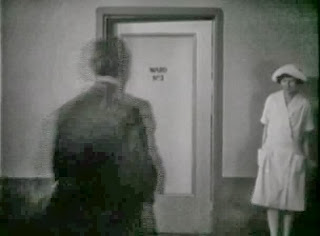A young man comes to New York with big dreams and a bit of good and bad luck - then life happens.
If there was a genealogical tree for movies than The Crowd would be very close to the root. There is not a minute where I didn't have the feeling that I've seen a similar scene in a newer film. The story beautifully combines a bit of romantic, comedic and tragic elements and at the end it has the effervescent melancholy similar to Chaplin's masterpieces. All is lost but hope.
There are two scenes that caught my eyes in terms of visual work. They might not be the best scenes in the film, but for inexplicable reasons I felt drawn into the frame.
The first one is, obviously, the depiction of crowds. A myriad of films have tried to depict crowds, and Vidor has managed to catch an air of the Koyaanisqatsi films by simply superimposing top shots of busy street crossings in New York. The technique is super simple, effective and... I like superimpositions. They are highly underused in today's cinema - unfortunately.
The second shot is when John Sims enters the ward to see his wife and his first, newborn child. It is a very long take on the dolly, that consequently follows the protagonist into the ward. The ward is or seems of a triangular shape (which I find really odd, but it's visually pleasing) and his wife's bed is at the far end.
The nurse opens the door, magically disappears to the right and then appears again on Johnny's hind right and leads him through the middle of the room towards his wife's bed. We never see his face, but his whole body language expresses his tension and wonder. When the dolly changes tempo twice the audience is with him. It's a magical shot.
If there was a genealogical tree for movies than The Crowd would be very close to the root. There is not a minute where I didn't have the feeling that I've seen a similar scene in a newer film. The story beautifully combines a bit of romantic, comedic and tragic elements and at the end it has the effervescent melancholy similar to Chaplin's masterpieces. All is lost but hope.
There are two scenes that caught my eyes in terms of visual work. They might not be the best scenes in the film, but for inexplicable reasons I felt drawn into the frame.
The first one is, obviously, the depiction of crowds. A myriad of films have tried to depict crowds, and Vidor has managed to catch an air of the Koyaanisqatsi films by simply superimposing top shots of busy street crossings in New York. The technique is super simple, effective and... I like superimpositions. They are highly underused in today's cinema - unfortunately.
The second shot is when John Sims enters the ward to see his wife and his first, newborn child. It is a very long take on the dolly, that consequently follows the protagonist into the ward. The ward is or seems of a triangular shape (which I find really odd, but it's visually pleasing) and his wife's bed is at the far end.
The nurse opens the door, magically disappears to the right and then appears again on Johnny's hind right and leads him through the middle of the room towards his wife's bed. We never see his face, but his whole body language expresses his tension and wonder. When the dolly changes tempo twice the audience is with him. It's a magical shot.






Kommentare